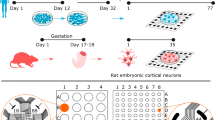Abstract
Various types of animal neurons were cultured on a microelectrode array (MEA) platform to form biosensors to detect potential environmental neurotoxins. For a large-scale screening tool, rodent MEA-based cortical-neuron biosensors would be very costly but chick forebrain neurons (FBNs) are abundant, cost-effective, and easy to dissect. However, chick FBNs have a lifespan of ~14 days in vitro and their spontaneous spike activity (SSA) has been difficult to develop and detect. We used a high-density neuron-glia co-culture on an MEA to prolong chick FBN lifetime to 3 months with lifetime-long SSA. A remarkable embryonic age-dependency in the culture’s morphology, lifespan, and most features of SSA signal was discovered. Our results show the feasibility of developing a chick FBN-MEA biosensor and also establish a new electrophysiological platform for functional study of an in vitro neuronal network.






Similar content being viewed by others
Abbreviations
- SSA:
-
Spontaneous spiking activity
- MEA:
-
Microelectrode array
- FBNs:
-
Forebrain neurons
- SCNs:
-
Spinal cord neurons
- M199:
-
Medium 199
- DIV:
-
Days in vitro
- En:
-
Embryonic day n
- ACC:
-
Active channel count, i.e., the number of active channels that are firing SSA signals from an MEA
References
Chiappalone M, Vato A, Tedesco MB, Marcoli M, Davide F, Martinoia S (2003) Networks of neurons coupled to microelectrode arrays: a neuronal sensory system for pharmacological applications. Biosens Bioelectron 18:627–634
Dugas-Ford J, Rowell JJ, Ragsdale CW (2012) Cell-type homologies and the origins of the neocortex. Proc Natl Acad Sci 109:16974–16979
Goldman LR, Koduru S (2000) Chemicals in the environment and developmental toxicity to children: a public health and policy perspective. Environ Health Persp 108(Suppl 3):443–448
Heidemann SR, Reynolds M, Ngo K, Lamoureux P (2003) The culture of chick forebrain neurons. Method Cell Biol 71:51–65
Johnstone AF, Gross GW, Weiss DG, Schroeder OH, Gramowski A, Shafer TJ (2010) Microelectrode arrays: a physiologically based neurotoxicity testing platform for the 21st century. Neurotoxicology 31:331–350
Kandel ER, Schwartz JH, Jessell TM (2000) Part I: The neurobiology of behavior. In: Principles of neural science. McGraw-Hill, New York
Kuhn TB (2003) Growing and working with spinal motor neurons. Method Cell Biol 71:67–87
Laurenza I, Pallocca G, Mennecozzi M, Scelfo B, Pamies D, Bal-Price A (2013) A human pluripotent carcinoma stem cell-based model for in vitro developmental neurotoxicity testing: effects of methylmercury, lead and aluminum evaluated by gene expression studies. Int J Dev Neurosci 31:679–691
Louis J, Pettmann B, Courageot J, Rumigny J, Mandel P, Sensenbrenner M (1981) Developmental changes in cultured neurones from chick embryo cerebral hemispheres. Exp Brain Res 42:63–72
Pasquale V, Massobrio P, Bologna LL, Chiappalone M, Martinoia S (2008) Self-organization and neuronal avalanches in networks of dissociated cortical neurons. Neuroscience 153:1354–1369
Pirlo RK (2009) Creation of defined single cell resolution neuronal circuits on microelectrode arrays. PhD Dissertation, Clemson University, South Carolina, USA
Potter SM, DeMarse TB (2001) A new approach to neural cell culture for long-term studies. J Neurosci Meth 110:17–24
Striedter GF (2005) Principles of brain evolution. Sinauer, Sunderland
Tokioka R, Matsuo A, Kioyosue K, Kasai M, Taguchi T (1993) Synapse formation in dissociated cell cultures of embryonic chick cerebral neurons. Dev Brain Res 74:146–150
Tsai HM, Garber BB, Larramendi LM (1981) 3H-thymidine autoradiographic analysis of telencephalic histogenesis in the chick embryo: I neuronal birthdates of telencephalic compartments in situ. J Comp Neurol 198:275–292
Wagenaar DA, Pine J, Potter SM (2006) An extremely rich repertoire of bursting patterns during the development of cortical cultures. BMC Neurosci 7:11
Wigle DT, Arbuckle TE, Walker M, Wade MG, Liu S, Krewski D (2007) Environmental hazards: evidence for effects on child health. J Toxicol Environ Health B Crit Rev 10:3–39
Ylä-Outinen L, Heikkilä J, Skottman H, Suuronen R, Aänismaa R, Narkilahti S (2010) Human cell-based micro electrode array platform for studying neurotoxicity. Front Neuroeng 3
Acknowledgments
This work was partially supported by funding from the National Institutes of Health through SC COBRE (P20RR021949), the National Natural Science Foundation of China (Nos. 31070847 and 31370956), and the Strategic New Industry Development Special Foundation of Shenzhen (No. JCYJ20130402172114948). Serena Y. Kuang designed the study, did most of the forebrain tissue dissection, cell culturing, MEA recording, data processing tasks, and wrote the manuscript. Zhonghai Wang was responsible for MEA technical support and programmed the MatLab-based software (NeuroMEA) for MEA data processing. Ting Huang translated all MEA data processing requirements into a flowchart with programming logic that oriented the development of the NeuroMEA software. Lina Wei contributed to chick forebrain and spinal cord dissection and some MEA recordings. Mark Kindy served as a senior researcher in this study and modified the manuscript. As PIs of the Project, Drs. Tingfei Xi and Bruce Z. Gao supervised the overall experimental design and data interpretation and modified and finalized the manuscript.
Conflict of interest
The authors declare no commercial or financial conflict of interest.
Author information
Authors and Affiliations
Corresponding author
Rights and permissions
About this article
Cite this article
Kuang, S.Y., Wang, Z., Huang, T. et al. Prolonging life in chick forebrain-neuron culture and acquiring spontaneous spiking activity on a microelectrode array. Biotechnol Lett 37, 499–509 (2015). https://doi.org/10.1007/s10529-014-1704-1
Received:
Accepted:
Published:
Issue Date:
DOI: https://doi.org/10.1007/s10529-014-1704-1




